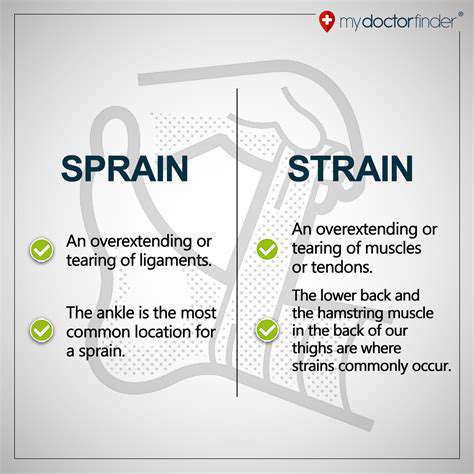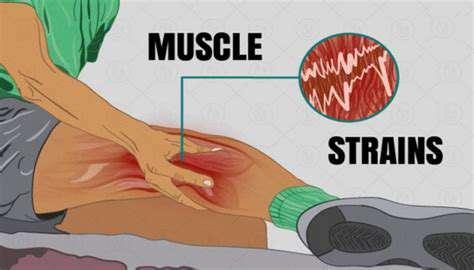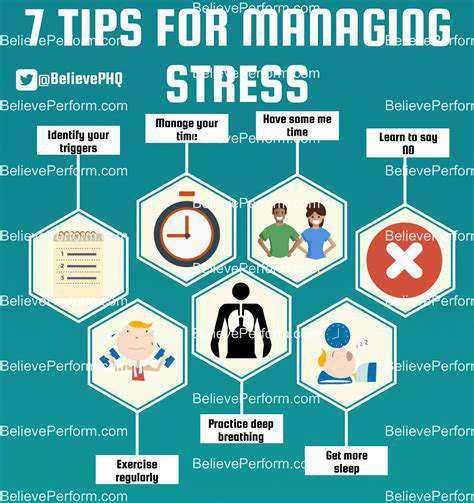Effective Strategies for Managing Muscle Tension and Strain
Identifying Muscle Tension and Strain

Understanding Muscle Tension
Muscle tension is a common physical response to stress, fatigue, or injury. It refers to the tightness and firmness experienced in muscles, which often leads to discomfort and can limit movement. Identifying this tension early can prevent more serious injuries and allow for quicker recovery. Understanding the triggers of muscle tension is essential, as it helps to develop effective management strategies and improves overall physical well-being.
A variety of factors can contribute to muscle tension, including poor posture, excessive workload, or emotional stress. The postural strain resulting from prolonged sitting or standing can significantly affect muscle health. Addressing these factors proactively is critical for both immediate relief and long-term wellness. For instance, frequent breaks during long periods of sitting can help alleviate the build-up of tension.
It’s also important to recognize the difference between muscle tension and muscle strain. While tension can be managed through relaxation techniques, strain typically involves injury and may require medical intervention. Being able to differentiate these conditions can guide individuals in selecting the appropriate treatment and prevention strategies.
Techniques such as stretching, deep breathing, and progressive muscle relaxation can significantly aid in reducing tension. Learning how to identify signs of muscle tension can empower individuals to take proactive steps towards managing their muscular health. In turn, this can lead to increased levels of comfort and enhanced performance in daily activities.
Recognizing Symptoms of Strain
Muscle strain occurs when the muscle fibers are overstretched or torn, often resulting from sudden movements or excessive physical activity. Symptoms can vary in intensity and may include pain, swelling, and limited mobility in the affected area. Recognizing these symptoms early can lead to effective treatment and prevent further complications. Being attentive to these signs is crucial for anyone engaging in physical fitness or labor-intensive activities.
Common indicators of muscle strain include a sudden sharp pain, increased sensitivity in the affected area, and even some bruising or swelling. Depending on the degree of the strain, symptoms can range from mild discomfort to severe pain that inhibits normal function. Understanding these signs may lead to early intervention and recovery.
A variety of factors can increase the risk of muscle strains, such as inadequate warm-up routines, dehydration, and poor flexibility. Muscles that are not properly warmed up are more susceptible to injury during strenuous activity. Implementing a thorough warm-up routine can be instrumental in reducing the likelihood of muscle strains. This might include dynamic stretching and gradual increases in activity intensity.
If strain symptoms are persistent or worsen, it is essential to consult a healthcare professional. Early assessment can provide proper guidelines for rehabilitation and return to activities safely. Ignoring significant pain or discomfort can lead to chronic issues that might require extended recovery time.
Effective Management Techniques
Managing muscle tension and strain effectively requires a comprehensive approach that includes rest, ice, compression, and elevation (RICE method). Rest is vital for muscle recovery, while ice helps to reduce inflammation. Applying these techniques can significantly alleviate pain and promote healing. Compression and elevation further assist in minimizing swelling and supporting the recovery process.
Incorporating regular stretching and strengthening exercises into a routine can dramatically improve muscle resilience. Flexibility training enhances range of motion, which can help prevent tension and straining. Strengthening the supporting muscles helps to stabilize joints and diminish overall stress placed on muscles during physical activities. It's essential to choose appropriate exercises based on individual fitness levels.
Mindfulness practices, such as yoga and meditation, can also be beneficial in reducing muscle tension. These techniques encourage relaxation and help individuals become more in tune with their bodies, allowing them to recognize tension before it escalates. Consistency in practicing these methods can lead to significant improvements in both physical and mental health.
Lastly, self-massage or professional therapy can provide targeted relief from areas of muscle tension and strain. Techniques such as trigger point therapy or myofascial release can address the root causes of discomfort and offer effective relief. This proactive approach to muscle care can significantly enhance one’s quality of life and physical performance.
Preventive Measures and Lifestyle Adjustments
Prevention is often the best strategy when it comes to managing muscle tension and strain. Making conscientious lifestyle choices contributes to muscle health. For instance, maintaining proper hydration levels is vital for muscle function and preventing cramps. A balanced diet rich in vitamins and minerals also supports muscle repair and recovery.
Regular physical activity, including both aerobic and strength-trainings exercises, plays a crucial role in overall muscle health. Engaging in a diverse fitness regimen not only builds endurance and strength but also promotes flexibility and reduces the likelihood of tension. Establishing a consistent workout schedule can provide long-term benefits to muscle care.
Ergonomic adjustments in workplaces and daily activities can significantly reduce muscle strain. This can include using adjustable chairs, standing desks, or ensuring tools are appropriately sized for individual use. By enhancing comfort and proper posture during activities, individuals can lower the risk of developing muscle tension or strain.
Lastly, educational resources on body mechanics and injury prevention can empower individuals to take charge of their muscle health. Workshops, online courses, or consulting with physical therapists are excellent options for learning effective strategies. Being informed and proactive sets the foundation for maintaining healthy muscles and avoiding injuries.
Causes of Muscle Tension and Strain

Understanding Muscle Anatomy
The human body consists of approximately 600 muscles, each playing a crucial role in movement and stability. These muscles can be categorized into three types: skeletal, smooth, and cardiac. Skeletal muscles, which are under voluntary control, are particularly susceptible to tension and strain due to their high demand during physical activities.
Anatomically, muscles consist of fibers that contract and relax, enabling various body movements. When these fibers are overstretched or overloaded, they can become tense or even damaged, leading to discomfort and reduced mobility. Understanding muscle anatomy can help in recognizing which specific muscles are impacted during an episode of strain.
Tension in muscles often correlates with the central nervous system responding to stress, fatigue, or injury. This response can lead to a cycle of tightness where the affected muscles become less mobile and more prone to additional strain.
Common Causes of Muscle Tension
Muscle tension is often the result of multiple factors, including poor posture, excessive physical exertion, or even emotional stress. Each of these factors can contribute significantly to the development of muscle strain and fatigue. For instance, consistent poor posture while sitting at a desk can lead to chronic tension in the neck and shoulder muscles.
Another area of concern is the impact of repetitive movements or overuse during physical activities. These repetitive tasks can lead to cumulative stress and micro-tears in muscle fibers, which ultimately results in painful tension. Professional athletes, laborers, or anyone who performs the same movements regularly should take special caution.
Emotional stress is often overlooked as a cause of muscle tension. The body tends to respond to stress by tensing the muscles, leading to chronic issues over time if not addressed. Awareness and relaxation techniques can greatly aid in alleviating this type of tension.
Impact of Lifestyle Choices
Daily habits and lifestyle choices can significantly influence the levels of muscle tension one experiences. Lack of physical activity can weaken muscles, making them more susceptible to strain. Conversely, excessive physical activity without proper recovery can also lead to muscle fatigue and injury. Finding a balance is essential for optimal muscle health.
Nutritional choices also play a crucial role in muscle function. A diet lacking in essential nutrients can contribute to muscle fatigue and cramping. Important nutrients like electrolytes, magnesium, and protein are necessary for muscle recovery and minimizing tension.
Inadequate sleep can further exacerbate muscle tension, as the body does not have sufficient time to repair itself. Prioritizing quality sleep helps the muscles recover and can diminish the likelihood of future strain.
Environmental Influences on Muscle Health
The physical environment in which one lives or works can significantly contribute to muscle tension and strain. For instance, ergonomically poor workspaces can lead to chronic muscle strain, particularly in the back and neck regions. Employers can play a pivotal role in promoting muscle health by providing ergonomic equipment. This not only helps mitigate tension but also enhances overall productivity.
Temperature conditions also impact muscle health, as cold weather can lead to tightened muscles and reduced blood flow, increasing the likelihood of strain. Staying warm and dressing appropriately for the climate can help maintain muscle flexibility.
Additionally, the psychological environment contributes to muscle tension. Stressful work environments may encourage tension in the body, particularly when employees feel pressure to perform. It is essential to create a supportive atmosphere that promotes relaxation and reduces tension.
Prevention and Management Techniques
Effective management of muscle tension starts with prevention strategies, which can mitigate strain before it occurs. Regular stretching exercises are vital in maintaining muscle flexibility and strength. Incorporating stretching into a daily routine can greatly reduce the incidence of muscle tension. Focused areas for stretching include the spine, shoulders, and hamstrings.
Additionally, strength training can be particularly beneficial as it builds endurance in muscle tissues. Engaging in strength training exercises, with proper guidance, can help develop balanced muscle support and resilience against tension.
Mindfulness practices, such as yoga and meditation, also serve as effective tools to manage stress-related muscle tension. By promoting relaxation and awareness of body movements, these practices can alleviate accumulated tension and enhance overall muscle health.
Strategies to Alleviate Muscle Tension and Strain
Understanding Muscle Tension and Its Causes
Muscle tension often arises from a myriad of factors, including physical stress, poor posture, and emotional strain. When the body is under duress, it instinctively clings to tension as a protective mechanism, making it crucial to identify the underlying causes. Routine activities, such as prolonged sitting or engaging in repetitive motions, can significantly contribute to discomfort and stiffness. Recognizing these patterns is the first step toward effective management.
Additionally, psychological components including anxiety and stress can exacerbate physical symptoms. Many individuals hold stress in their muscles without realizing it, leading to chronic tension. Mental health plays a significant role in physical well-being, and approaches aimed at reducing psychological stress can also help alleviate muscle tension. As holistic treatments gain traction, it's important to consider both mind and body when addressing this issue.
Furthermore, dehydration and poor diet can influence muscle health, making nutrition fundamental in the prevention of strain. Adequate hydration is essential for maintaining elasticity in muscles, while a balanced diet rich in nutrients supports muscle repair and recovery. Incorporating foods high in protein, vitamins, and minerals can promote muscle function and overall health, aiding in the reduction of tension and discomfort.
Effective Stretching Techniques for Relief
Incorporating stretching into your daily routine can significantly reduce muscle tension and promote flexibility. Dynamic stretching, which involves movement-based stretches, is often beneficial before engaging in physical activities. These stretches warm up your muscles, preparing them for exertion and potentially reducing the risk of injury. A simple routine can involve moves like arm circles and leg swings to enhance blood flow.
Static stretching is equally vital for muscle relaxation post-activity. Holding stretches for a sufficient duration, around 15-30 seconds, allows the muscle fibers to relax and lengthen. Focus on key areas where tension is common, such as the neck, shoulders, and back. Deep breathing should accompany these stretches, as this combination of techniques helps to calm the nervous system while alleviating tension.
Moreover, incorporating targeted stretches into your work breaks can fend off tension and improve productivity. Utilize stretches such as neck rolls or seated twists, which can be performed discreetly at your desk. Regularly moving the body, even for a short time, better equips you to manage stress and maintain a relaxed state throughout the day, ultimately contributing to reduced muscle strain.
Mindfulness and Relaxation Techniques
Mindfulness practices can be an integral part of alleviating muscle tension. Approaches like meditation and deep breathing exercises foster awareness of bodily sensations, helping individuals notice areas of tightness and stress. Cultivating this awareness enables proactive responses to tension, promoting relaxation techniques such as visualization or gentle guided imagery.
Progressive muscle relaxation (PMR) is another effective strategy. This technique involves systematically tensing and then relaxing different muscle groups, which can lead to an emotional state of calm and clarity. By focusing on each muscle’s tension, you can develop a greater understanding of where stress resides, and through relaxation, offer your body a reprieve from discomfort.
Incorporating these practices into your daily routine may enhance mental resilience while minimizing physical tension. Online resources and local classes can guide newcomers in safely exploring these techniques. Making a commitment to mindfulness not only alleviates muscle strain but also nurtures a healthier mindset conducive to overall well-being.
Role of Exercise in Muscle Health
Regular physical activity is fundamental to muscle health, as it promotes blood circulation, thereby nourishing muscle tissues and removing toxins. Engaging in both aerobic and strength-training exercises can enhance muscle flexibility and reduce overall tension. Even activities like walking or cycling can trigger the release of endorphins, which serve to elevate mood and diminish pain perception.
Targeted strength training is crucial, specifically focusing on underutilized muscles that detract from overall stability. Exercises like lunges, resistance band training, and yoga can improve muscular balance, enhancing support to key joints and reducing the likelihood of strain. Incorporating a variety of workouts into your regimen can also prevent monotony and keep you engaged.
Moreover, consistency is key. Establishing a routine that gradually builds strength and endurance will leave your muscles less prone to tension over time. Working with a fitness professional can help tailor an exercise plan that aligns with your personal goals, ensuring you're practicing safely while effectively managing any pre-existing muscle strain. This holistic approach sets the foundation for a resilient body.
The Importance of Listening to Your Body
Understanding Your Body's Signals
Listening to your body is crucial for recognizing signs of discomfort or strain. Muscle tension often manifests as tightness, stiffness, or pain, indicating that something may be amiss. By paying attention to these signals, you can take proactive steps to address potential issues before they escalate into more serious conditions. Ignoring these signals may lead to chronic pain or injury, which can significantly impact your overall quality of life.
Additionally, understanding your body’s signals can help you differentiate between normal muscle fatigue after a workout and warning signs of injury. Educating yourself about your body’s normal range of motion and strength can enhance your ability to identify abnormalities. This knowledge empowers you to make informed decisions about when to rest and when to push yourself further, fostering a healthy balance in your fitness routine.
Implementing Regular Self-Assessment Practices
Incorporating regular self-assessment practices into your daily routine can greatly benefit your ability to manage muscle tension and strain effectively. Simple techniques such as stretching, mobility exercises, and mindfulness can enhance your awareness of your body's condition. Taking just a few minutes each day to check in with yourself helps to establish a connection between your mind and body, making it easier to recognize any changes in tension levels or discomfort.
Furthermore, keeping a journal can provide valuable insights into your body's responses to various activities. Recording instances of tension, strain, or pain along with your physical activities can help you identify patterns and triggers. This information can be immensely useful when consulting with a healthcare professional, allowing them to tailor advice and strategies to your specific needs, ultimately aiding in muscle relaxation and recovery.
Balancing Activity and Rest
Finding the right balance between activity and rest is fundamental in managing muscle tension and preventing strain. Engaging in a regular exercise routine is essential for maintaining muscle strength and flexibility, yet it is equally important to incorporate rest and recovery periods. Overworking your muscles without adequate rest can lead to increased muscle tension, reduced performance, and higher risk of injury.
To achieve a balanced regimen, consider integrating restorative practices such as yoga, deep breathing exercises, or gentle stretching sessions into your routine. These activities promote relaxation and help to alleviate built-up tension in your muscles. Additionally, listening to your body and recognizing when it needs a break can foster a healthier attitude towards exercise, preventing burnout and encouraging long-term sustainability in your fitness journey.
Seeking Professional Guidance
Sometimes, despite your best efforts, muscle tension and strain may persist, indicating the need for professional guidance. Engaging with health and wellness professionals such as physical therapists, chiropractors, or sports trainers can provide you with tailored strategies to manage your specific conditions effectively. These experts can assess your muscle condition, analyze your posture, and provide targeted exercises and therapies designed to relieve tension while promoting proper body mechanics.
Moreover, professional guidance extends beyond physical assessments. Many practitioners teach therapeutic modalities, such as mindfulness techniques or pain management strategies, empowering you to take control of your health. Establishing a relationship with a skilled professional not only enhances your understanding of your body but also ensures you have ongoing support throughout your journey in managing muscle tension and strain.







